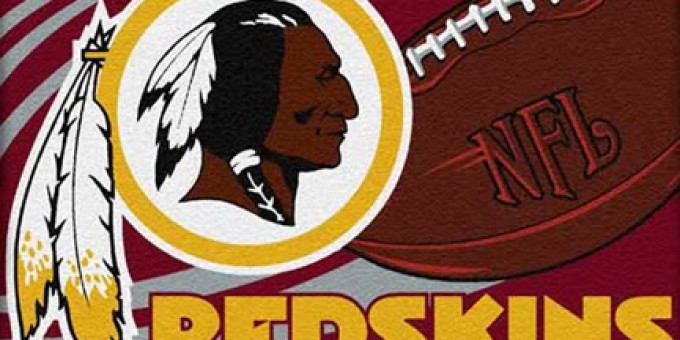
In the spring of 2013, a racial controversy emerged in that usually rarified, entertainment realm of sport. It had to do with the “Redskins” moniker used by the NFL’s Washington, D.C. , franchise, one of the most prominent and profitable in the league. Long a symbol of frustration for Native American activists and advocates, a powerful new movement to eliminate the mascot emerged. One D.C. city councilman urged the team to change their name to the “Redtails” and 10 members of Congress sent a letter to owner Daniel Snyder adding their voices to the plea. Snyder did not waver. Instead, he told the media his team would “NEVER” (his emphasis) change its name.
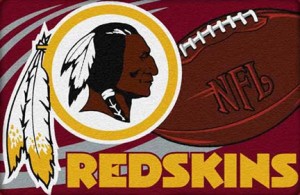
As with most U.S. controversies, everyone from celebrities to armchair quarterbacks has an opinion about the capitol city’s team. Robert Griffin, III, Washington’s star quarterback, offered his opinion (via 140 characters on Twitter): “In a land of freedom we are held hostage by the tyranny of political correctness.” Jonny Levin and the satirical staff at Funny or Die offered their take, calling for the Redskins’ owner to make the team’s name even more derogatory. Even right-wing rock legend Ted Nugent chimed in, telling one journalist that the call to do away with Native American mascots was being pushed by the “terminally disconnected” who “waste [their] time and energy focusing on things that matter about as much as a giant ball of string.”
If you live in Michigan or Oregon, Wisconsin or Illinois, it is likely that within the last decade you’ve heard similar discussions and debates—often quite heated—about the use of Native American names, symbols, and performances for sports teams. You might even know a child who attends a school known as the Indians, Warriors, or Chiefs.
Be they elementary or professional teams, sporting clubs’ use of Native American names, imagery, and metaphors as a vehicle for identification is pervasive. At the core of the discussion over the use of these representations are very serious racial divides. The historical conditions that influenced the creation and use of “Redskins” and other Indian monikers, in sport or otherwise, explicitly complicate the entire idea of the United States as the land of opportunity. The names, images, sounds, and metaphors gloss over the past, and their supporters care little about the impact of stereotypical imagery on members of the community that is being represented.
What is at stake in all of this is nothing less than an understanding of the history of Native Americans, the problems with racial stereotypes and caricatures, and the role of sport in the construction and contestation of race itself.
How Mascots Became Racialized
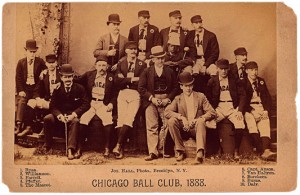
The term mascot, derived from the French mascotte and Portuguese masco, originally referred to any object or talisman that brought luck to a person or household. The mascot was often an object of sorcery and mystery with otherworldly origins. Mascots were also religious talismans that wives and mothers bestowed upon men to protect them from death and disease in battle. “Mascot” over time came to mean young boys who followed troop divisions in wars, helping protect soldiers as sort of human talismans.
When it came to sport, the young boys who would take on small team responsibilities—caring for bats and getting the team refreshments—in early games of baseball and football were equated with the battlefield helpers. These mascots brought good luck to their team as their predecessors had to their army.
Soon, though, sporting mascotry was racialized and relied on notions of racial hierarchy and identity that equated blackness to animalism. In one prime example, at the turn of the nineteenth century, the Chicago White Sox employed a former vaudeville performer, Clarence Duvall, as their mascot. “His grin is broad, his legs limbre and his face as black as the ace of spades,” wrote one Chicago newsman. “Whenever anything goes wrong, it is only necessary to rub Clarence’s wooly head to save the situation, and one of his celebrated ‘double shuffles’ to dispel all traces of care, even on the gloomiest occasion.” Historian Adrian Burgos writes of a White Sox stop in Cairo, Egypt, where “several ballplayers forced [Duval] to wear a catcher’s mask and glove and then paraded [him] about the Cairo railway station, tethered by a rope, ‘as if he was some strange animal let loose from a menagerie.’” Mascots were treated as property to be mocked or even physically abused.
At the same time as white and African American mascots performed along the sidelines, Native athletes playing in professional sport in the late nineteenth and early twentieth century experienced racial degradation on the field. Louis Sockalexis, Charles A. Bender, John Tortes Meyers, Jim Thorpe, and others faced racist taunts. Some were physically assaulted. All were treated as less than their white counterparts in everything from playing time to contract negotiations to housing. For those who saw the recent biopic 42, such scenes might be vividly at hand, but they must be amplified. Native American players were treated as something between offensive and exotic, but they were always a target.
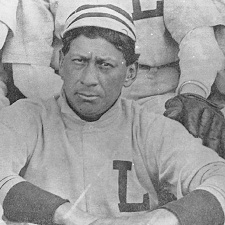
The “redskin” moniker is just one example of this. Although originally used as a physical descriptor by Europeans who encountered Native peoples, the term redskins has seen complex uses. Its first public recorded use was at the White House in 1812, but it also appeared in the work of James Fenimore Cooper, in records of treaty debates, in poetry, film, advertisements, and (as explored here) in the names and trademarks of sports teams.
Yet, the benign use of “redskin” when President James Madison welcomed a delegation of tribes to discuss military alliances was marred by the behaviors of citizens who advertised bounties for redskins and hung Indian scalps as trophies in their homes and stores. While direct physical conflict declined after 1840 (particularly in the east post-Indian removal), the use of cultural tropes surrounding Indian identity grew. Natives were alternately portrayed as violent savages who should be quarantined on reservations far away from polite (read: white) society or as majestic, honorable, peaceable people who must be saved. Both tropes were enshrined in popular fiction, in visual performances like Wild West Shows and films, in music, and in commercial advertising. Indians whooped and hollered, hunted innocents, communed with nature, and otherwise traversed the pages of public imagination.
Today, when we talk about whether Native mascots are appropriate, their history is glossed over. We’d like to think the behaviors and experiences are past, that the United States is a melting pot in which explicitly racialized exchanges have given way to appreciation of great play and extraordinary people. We like to think the country has either outgrown its dark history or we conveniently forget about that history all together.
An Oppressive Past
“In 1492, Columbus sailed the ocean blue,” begins the school rhyme familiar to many. It goes on to say that Columbus encountered the Arawaks in the Bahamas, where they all enjoyed a peaceful exchange and Columbus departed. The door was now open to centuries of European exploration in the Americas. In this telling, it is a great story, but for the Americas’ indigenous peoples, European exploration, motivated by quests for land, riches, and even religious freedom, also introduced centuries of violence, oppression, and conquest to their lives. Native Americans experienced dramatic population declines, intra- and extra-tribal warfare, and exploitation at the hands of Spanish, French, and English colonists.For all these traumatic factors, the story of Native peoples is also one of persistence and flourishing within the confines of colonialism. Empires have fallen and nations have been founded in the 500 plus years since that famous encounter. Native American societies live on.
According to the 2010 U.S. Census, 5.2 million people self-identify as Native American or Alaska Native (alone or in combination with other racial categorization). Nearly 2 million are members of 562 federally recognized tribes, and hold all of the rights of U.S. citizens, as well as those of their tribal citizenship. Indian tribes and individuals lay claim to over 56 million acres of land held in federal trust, and there are 326 tribal reservations administered by the U.S. government.
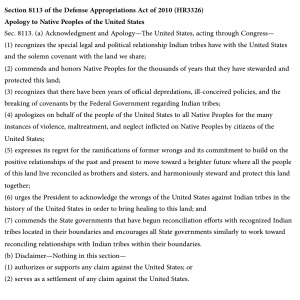
Unsettlingly, Native Americans also experience the highest rates of unemployment and poverty in the United State’s. Whether living on a reservation or in a city, their rates of alcoholism, diabetes, infant mortality, and adult mortality are dramatically higher than the rest of the U.S. population. In just the past few years, the government has moved to recognize, but not right, the wrongs perpetrated against these tribal citizens and their lasting effects. In the Defense Appropriations Act of 2010, the U.S. Senate formally acknowledged and apologized for its past treatment of Native Americans. Tellingly, though, HR3326 specifically pointed out that an apology would not be followed by any formal action. It closes: “Nothing in this section authorizes or supports any claim against the United States or serves as a settlement of any claim against the United States.” We’re sorry, it seems to say, but not that sorry.
For many indigenous peoples, the legacies of colonialism are alive and well. Their cultures are lumped together, at once totemic and disregarded. Comprising of politically and culturally distinct groups, they are universally “Indian” in cultural memory—few others in the United States could describe the differences between the Menominee and Seminole tribes or explain whether a Mohawk is a group or a haircut. It is that history that is at play when we discuss whether Redskins and Warriors are appropriate team names, appropriate mascots. It is this legacy that makes so many cringe at a crowd of sports fans showing off the famous “Tomahawk Chop.”
Contemporary Consequences
The injuries of colonization, the loss of life, misappropriation, and misinterpretation, though, are not just historical facts—they have contemporary consequences. The “Tomahawk Chop” mimics the scalping of battle opponents, a cultural memory of the violence of colonization for Indians and colonists alike. Sacred iconography, in the form of clothing and headdresses, are divorced from their communities of practice, their meanings distorted and corrupted. And, so very basically, the use of “redskins” is a racial slur. While sociologists and psychologists have noted that the use of Native mascots negatively impacts senses of self-worth, particularly among young children, more broadly, states like Michigan and Wisconsin have found that the use of Native mascots constitutes a harmful educational environment by presenting limited, racialized views of Natives.
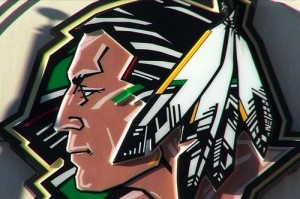
The consequences of totalizing imagery, in which “one Indian is the same as another,” have been readily documented by sociologists like Stephanie Fryberg, John Gonzalez, and Angela LaRoque. In case studies, Fryberg reveals that, regardless of the conditions of their creations and use (that is, whether it’s the Haskell University mascot, which was created by Indians, or another mascot created and used by a predominantly white university), representations of Indian mascots lead Native participants to express depressed self-esteem, among other psychological costs. At the University of North Dakota, where the team was called the “Fighting Sioux” until a 2012 state vote, Gonzalez showed that Native students were “more likely targets of racial prejudice and potential discrimination,” and LaRoque found that daily exposure to the “Fighting Sioux” logo led Native students to have higher levels of negative affect and psychological distress. Why, you might ask, aren’t the schools happy to simply change their team name to something more benign, like Minnesota’s “Golden Gophers” or Houston’s “Oilers”?
Much of this comes together in the court cases that have begun to reshape the mascot landscape in recent decades.
From the Court to the Courts
In 1992, Suzan Shown Harjo, poet, activist, and former executive director of the National Congress of American Indians, joined Vine Deloria Jr. and others to sue Pro Football, Inc. to cancel the trademarks related to the term “redskins” and its portrayal. The petitioners claimed that the trademarks were disparaging to Native Americans under the Lanham Act, which states that a petition to register a trademark be refused if it “consists of or comprises immoral, deceptive, or scandalous matter; or matter which may disparage or falsely suggest a connection with persons, living or dead, institutions, beliefs, or national symbols, or bring them into contempt, or disrepute.” After years of legal wrangling, the Trademark and Trial Board declared that the petition had not been lodged speedily enough before the courts—the terms had been in use for decades, but only now brought before a court. The case was returned to the lower court to be revisited.
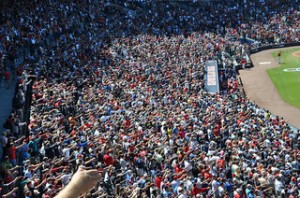
Fourteen years later, in 2006, six (now five) new plaintiffs filed a new petition to cancel the trademark, backed by the legal evidence gathered in the Harjo case. Blackhorse et al. v Pro Football, Inc. alleges that, because each plaintiff had just reached the age of majority in 2006, there had been no unreasonable delay in their complaint. Thus, the petition claims that the case must rest on the evidence of the Redskins name and associated marks being disparaging, scandalous, and otherwise offensive to Natives. Oral arguments were heard March 7, 2013.By early to mid-2014, the Trademark and Trial Board will release its new conclusions. Undoubtedly, there will be additional appeals and counter appeals, no matter how the decision is reached. For our purposes, though, it is useful to consider two avenues of exploration: what constitutes injury and how it is proven, and where sport fits into the debate.
In the legal cases of Harjo and Blackhorse, the evidence of injury to the plaintiffs includes personal testimonies, the results of psychological surveys and polls, historical documents outlining the history of the term redskins, and other documents allegedly proving these trademarks are deleterious to Native peoples. And even as proof of injury was amassed, the plaintiffs can show, Indian mascotry spread in the twentieth century. From Dartmouth to Stanford, Indian mascots took the field. Over 70% of these institutions have now “retired” or removed their mascots, but that still leaves an awful lot of “Indians,” “Warriors,” and “Redskins.”
Arena of Debate
Sport serves a microcosm of contemporary life. It focuses issues of capitalism, market economies, cultural belonging, and play around consumptive behavior. It is simultaneously play and moral training… except when it is a billion-dollar-a-year business that relies on quantities of young, healthy bodies performing for the benefit of institutions and organizations. Sport generates massive streams of revenue wrapped in the rhetoric of enjoyment and character building. It is a privileged space with millions of contributors, from community-based Pee-Wee Leagues to ESPN’s First Look.
So, when Dan Snyder says his team will always be the “Redskins,” his assertions are not just about a perception that a small handful of “politically-correct activists” are trying to force their way upon the rest of us. It is about a legacy of violence, oppression, and cultural heritage intertwined with the right of corporations to use that heritage for profit in a global economy. In a way, Snyder’s defensive, blustering opinion makes sense—he’s a businessman with a lot at stake. But why would fans get in on the action? Aren’t the players the same, the games as competitive, the regional and city affiliations as strong, whether the mascot is a “Redskin” or a “Wizard”?
Defenses of Native American mascotry often rely on personal anecdotes and polling data (the “four out of every five respondents” who told the Associated Press they don’t find mascotry offensive). They talk of “honoring Indians” and often trot out personal testimony from “an Indian friend” who says he or she doesn’t find the various terms and images offensive. And they remind others that the teams themselves have a proud history as the “Redskins” or the like; the team’s performances have redeemed the name, making it a testament to the prowess of Native Americans, not a slur implying savagery on the field.When Snyder and others mythologize the Redskins name, they draw upon a massaged version of history in which the team’s one-time owner George Preston Marshall, a virulent segregationist and neo-Confederate, meant to honor Natives and preserve their history. As sportswriter and columnist Dave Zirin has remarked, “the name represents the team’s history of great players,” yet fails to recognize how many of those players are offended by the banner under which they play.
Sociologists Ellen Staurowsky, Pauline Turner Strong, and Charles Fruehling Springwood have explored the motivations behind both whites and Natives supporting pro-mascot factions. In her look at the NCAA policy banning the use of Native American imagery and mascotry at post-season events, Staurowsky writes simply that the “cultural appropriation of American Indians is not neutral.” The ability of whites to deploy Indianness relies on “primers of White privilege, where taking without asking or regard is not socially impolite, morally corrupt, educationally harmful, or legally criminal but an acceptable mode of behavior for masses of Americans…” The notion that, as Americans, “we are all Indians” relies on disingenuous claims. Using Indians as mascot symbols amounts to social control. Non-Indians are denying the rights of Indians to express their own identity in a space free from judgment and commercialism.
Expanding on this, Turner Strong says appropriation is a clear indicator by dominant, white society that Native Americans cannot be fully recognized as valued citizen-participants in the United States When pro-mascot advocates cry “political correctness run amok,” they are also maintaining the political and economic inequalities that have denied Natives the right of self-determination for centuries.
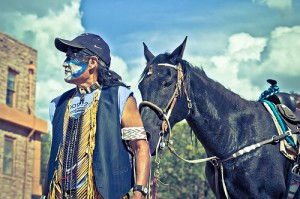
An undercurrent of the entire argument is the ability to strategically claim Indian identity. Charles Fruehling Springwood demonstrates that white people have fabricated Indian heritage (biological or metaphorical) tactically. Calling them “Indian wannabes,” Springwood says these individuals claim Nativeness (usually via some long-lost relative or fabled ancestor) not to participate in Native community but as an “opportunistic annunciation” that allows them to back pro-mascot movements and mute actual Indian voices. It’s a strange mutation of the “Some of my best friends are black…” segues used in blustering defenses of anti-black sentiment today. And these revisionist personal histories are often intertwined with revisionist corporate histories.
Revisionist histories are not unique to the Redskins. They are a universal construct within the pro-mascot debate. Histories of universities, colleges, even local public schools, have been rewritten. The public is led to believe that these historical origin tales are all sunshine and light, rather than continuing skirmishes in a centuries-old battle for Native peoples to not just live, but to represent themselves freely and openly.
Since the earliest accounts of explorers’ encounters with Native Americans, there’s been an almost patronizing fascination. Today it’s not just in memoirs and diaries, but on television, in films, in commercials, and at halftime. It plays out in ticket sales and Sunday afternoon commentary. It plays out in courts and on campuses. And it will play out until Native Americans gain the right to define themselves and their lives within mainstream cultural production.
Recommended Reading:
Stephanie Fryberg, H.R. Markus, D. Oyserman, and J.M. Stone. 2008. “Of Warrior Chiefs and Indian Princesses: The Psychological Consequences of American Indian Mascots,” Basic and Applied Social Psychology 30(3): 208–218. Four case studies that explore the consequences of American Indian mascots on Native high school and college students, as well as community members.
C. Richard King and Charles Fruehling Springwood (eds). 2001. Team Spirits: The Native American Mascots Controversy (Lincoln: University of Nebraska Press). Highlights case studies of the Washington Redskins, the Cleveland Indians, and the University of Illinois’s Chief Illiniwek, as well as the Florida State Seminoles and Marquette University.
Charles Fruehling Springwood. 2004. “’I’m Indian Too!’: Claiming Native American Identity, Crafting Authority in Mascot Debates,” Journal of Sport and Social Issues 28(1): 56. Examines the ways in which Americans, particularly white Americans, have strategically claimed Indianness to argue in favor of Native American mascots thereby disenfranchising Natives from their own identity.
Ellen J. Staurowsky. 2007. “’You Know, We Are All Indian’: Exploring White Power and Privilege in Reactions to the NCAA Native American Mascot Policy,” Journal of Sport and Social Issues 31(1): 61. Explores the effects of the 2005 National Collegiate Athletic Association’s post-season ban on Indian mascots by highlighting what responses to the ban reveals about white people, power, and privilege.
Pauline Turner Strong. 2004. “The Mascot Slot: Cultural Citizenship, Political Correctness, and Pseudo-Indian Sports Symbols,” Journal of Sport and Social Issues 28(1): 79. Drawing on Aihwa Ong’s concept of cultural citizenship and Michael-Rolph Trouillot’s notion of the “savage slot,” Strong argues that mascotry serves as a form of cultural citizenship and control that offers obstacles to full participatory citizenship by Native Americans.

Comments 12
Letta Page — October 18, 2013
Sociologist Jay Livingston adds another interesting comparative image about mascots over on SocImages today: http://thesocietypages.org/socimages/2013/10/17/resistance-to-the-redskins-mascot-racism-in-perspective/?utm_source=feedburner&utm_medium=feed&utm_campaign=Feed%3A+SociologicalImagesSeeingIsBelieving+%28Sociological+Images%3A+Seeing+Is+Believing%29
Friday Roundup: Oct. 25, 2013 » The Editors' Desk — November 8, 2013
[…] Sociological Images provides their annual Halloween roundup and uses a great image to think about Native American mascots. For more on mascots, check out Jen Guiliano’s TSP feature. […]
La noirceur du petit ramoneur | Déjà vu — December 9, 2013
[…] en référence implicite et parfois explicite à celle-ci. On rappellera enfin que des mascottes raciales – très proches dans cette fonction de porte-bonheur – ont aussi été utilisées dans […]
Miss Politically Incorrect — February 21, 2014
What the leftists fail to understand is that this is a first amendment issue. The left is forever wanting to ban everything no grounds that it is offensive. That is precisely the point of the first amendment. It is there to protect ALL speech - not just that speech deemed acceptable by people like you. There are lots of things I find offensive - that doesn't mean I think they should be banned. Other people have the right to have an opinion that is different from mine. Oh and by the way I am of 'mixed race' - Italian and Indian/Pakistani and I am so tired of White so called liberals trying to claim the moral high ground that they and they alone know what is best for everyone. I find it offensive the way white people are constantly demonised. Where do we draw the line? I am half Italian - should we ban Super Mario and portrayals of Italians as Mafioso in films and popular culture because they are offensive? I guess that doesn't count because Italians are white? What about the Irish? I could go on and on. It is the criminalisation of speech by the left that is encroaching on every area. And as Ted Nugent says, there are far more important things to be worrying about than this contant obsession with identity politics.
bob rodgernel — March 10, 2014
i love you austin will you marry me???
AUstin — March 10, 2014
YES i will marry you!!!
the "Original Americans" and Self-Serving Philanthropy | Dr. Jennifer Guiliano — March 25, 2014
[…] August, I wrote a piece on “The Fascination and Frustration with Native American Mascots” for the Society Pages. I wrote about how sporting clubs’ used Native American names, […]
Friday Roundup (Monday Edition): Oct. 14, 2013 » The Editors' Desk — April 1, 2014
[…] “The Fascination and Frustration with Native American Mascots,” by Jennifer Guiliano. A look at the history and fight over mascots, as the Redskins go 1-4 in the NFC East. […]
Letta Page — September 17, 2014
Deadspin reports that, in 2014, broadcasters are using the term "Redskins" far less, favoring, instead, "Washington." http://regressing.deadspin.com/broadcasters-really-are-saying-redskins-a-lot-less-th-1635806862/+tcraggs22
Playing America’s Games: Mascots and the Color Line | The Politic — October 26, 2016
[…] were often founded with racial discrimination in mind––mascots were fundamentally meant to be ideas that could be treated as symbolic properties to be played with and even mocked by people that could […]
President’s Forum: Racialized Mascots – North American Society for Sport History — May 18, 2017
[…] The Fascination and Frustration with Native American Mascots […]